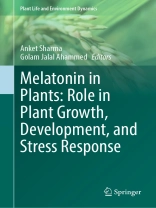This edited book compiles multifaceted functions of melatonin in plant growth, development, and stress response. The main focus of the book is to address the recent most developments in the arena of melatonin-mediated regulation of stress tolerance.
Plants are continuously challenged by both biotic and abiotic stressors, which have negative impacts on growth and development. Stimulation of exogenous cues and endogenous signals can help plants to better withstand biotic and abiotic stresses. Melatonin is an important biologically active compound that acts as a multifunctional signaling molecule and regulates key physiological and biochemical processes. Currently, researchers all over the globe have been exploring the in-depth mechanisms of melatonin-modulated regulation of plant biology using various advanced molecular techniques. These recent advancements in melatonin research have possible applications in plant stress management as well as developing stress-tolerant cropvarieties.
This book is of interest to university teachers, researchers, plant scientists, industry professionals, and policymakers on a global scale.It also serves as a reading material for undergraduate and graduate students of agriculture, forestry, plant biology, and environmental sciences.
สารบัญ
Chapter 1-Phytomelatonin: History, Biosynthesis, and Functions, – Chapter 2-Melatonin: A critical regulator of plant growth and development, – Chapter 3-Regulation of Photosynthesis by melatonin under optimal and sub optimal conditions, – Chapter 4-Melatonin and its crosstalk with plant hormones under stressful environments, – Chapter 5-Interaction between melatonin and other signaling molecules in plants, – Chapter 6 – Melatonin in safeguarding plants from high light and UV exposure, – Chapter 7- Melatonin in plant tolerance to drought stress: physiological and molecular interventions, – Chapter 8- Effect of Melatonin in Regulating Salt Stress Responses in Plants, – chapter 9-Melatonin and cold tolerance in plants, – Chapter 10-Physiological and molecular mechanisms of melatonin-induced tolerance to heavy metal stress, – Chapter 11-Melatonin biology in plants under biotic stress: physiological and molecular aspects, – Chapter 12-Role of melatonin on post-harvest physiology ofcrops, – Chapter 13 -Advances in tools and techniques to quantify melatonin in plants and foodstuffs.
เกี่ยวกับผู้แต่ง
Dr. Anket Sharma is currently working as a Visiting Scientist at Texas Tech University, Lubbock, USA. Additionally, Dr. Sharma is also working as an Adjunct Associate Professor at Zhejiang A&F University, China. Prior to that, , he worked as a postdoctoral scientist at Zhejiang A&F University, China. He did his Ph D in Plant Science from Guru Nanak Dev University, India. He also got a DST-INSPIRE fellowship from the Department of Science and Technology, Government of India. His research interests are to study plant hormone-mediated regulation of plant physiology under abiotic stress conditions. He has authored over 100 publications in internationally reputed journals. Dr. Sharma has been listed in the “Highly Cited Researchers 2022” by Clarivate Analytics. .
Dr. Golam Jalal Ahammed is an associate professor at the Department of Horticulture, College of Horticulture and Plant Protection, Henan University of Science and Technology, Luoyang, China. Dr. Ahammed received a Ph D in Olericulture with a major focus on Plant Stress Physiology and Hormonal Regulation in 2012 from Zhejiang University, China. Afterwards, he completed two consecutive postdoctoral programs at the Institute of Pesticide and Environmental Toxicology and the Institute of Crop Science of Zhejiang University. His major research interests include plant stress physiology, phytohormones, climate change effect on plants, biological control of plant diseases, and environmental pollution. Dr. Ahammed has authored over 160peer-reviewed papers in internationally reputed journals. He is a senior editorial board member and an associate editor in prestigious journals












